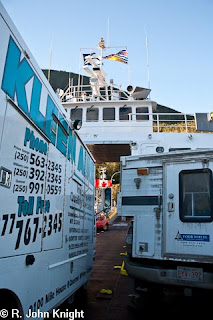Well, we're home after being away for 3 weeks.
We had headed towards Bella Coola on Sept. 22nd to join some photographers at Chilko Lake to photograph grizzlies for a week. At least, that was the plan. However, 'mother nature' intervened.
Since we had arrived in the area a couple of days early, we drove down 'The Hill' to Bella Coola, just as the rain started.
We stopped at Hagensborg, a few kilometres east of Bella Coola, for gas and a few groceries late Friday afternoon. It was here that we learned about the significant storm headed our direction. We hunkered down for the night at a local campsite, not wanting to try driving back up 'The Hill' in the dark, but planning to leave first thing in the morning.
It rained heavily all night. When I looked outside in the morning, there were large ponds of water in the campsite, and the road back to the highway was under water. And, there was no water for the toilets or showers.
We quickly had something to eat, then drove through ~20 cm of quickly flowing water back onto Highway 20, and headed east. We didn't get far. A flagman was standing in the middle of the road. The road was washed out just around the corner, and there were apparently about 14 other washouts between Hagensborg and the bottom of 'The Hill'.
We headed back the other way, past the campground turnoff where water levels were already noticeably higher. The accesses to the gas station and local store were flooded, and the road to Bella Coola was under water and impassable. We were trapped with rising water all around us.
I checked our GPS to locate road access to higher ground. It turned out to be at the local high school in Hagensborg. We parked there for most of the day while it continued to rain, and the rivers and streams flooded. Periodically, we drove out onto the highway to see if anything had changed.
About mid-afternoon, a local invited us to their house for tea. A few hours later, however, the road to their house was under water, and threatening to be washed out by the rapidly moving water. So, with the threat of being cut-off, we helped these people load up a few things, mainly food and clothing, and we headed further up-valley and up-slope to an empty house that was on well-water. The owners were working in Vancouver. This is where we stayed, safely above the flood for the next two days. We slept in our camper, and shared our meals and cooking with our new friends and hosts, Stewart, Shirley and Marilyn, their four canine pals, and friends, Mike and Clare. While this was happening, Stewart headed off to work on the local roads and clearing culverts of debris with other road crews.
By late Monday, the rains had eased off and the flood waters began to recede. With the water turned back on in Hagensborg Tuesday afternoon, albeit with a 'boil order', we helped moved our hosts move back into their home. The flood waters did not wash out their road, but had come to within ~20 cm of the main floor of their house. Fortunately, they had no basement, but the crawl space was full of mud and water Their workshop/business building had been flooded by about 1.5 m of water, judging from the watermarks on the walls, and was now loaded with water-sodden items and about 10-15 cm of wet silt.
Since we had not been in touch with any of the local authorities, we registered with the RCMP and the emergency staff at the Central Coast Regional District office. We were able to confirm that the only road out of Bella Coola would be closed for at least a month, if not longer. There were apparently kilometre sections washed out by the 200-250 mm of rain that had fallen.
We learned that Tweedsmuir Travel was trying to organize a ferry with the BC government to evacuate stranded visitors like ourselves. The seasonal ferry that serves Bella Coola twice a week during the summer had just gone into dry-dock mid-September for its winter maintenance.
For the next two days, we retrieved and re-stacked firewood and other items that had floated away, and shoveled silt from buildings and basements at our host's place, and at some of their neighbor's nearby.
On Wednesday evening, we heard that we were on a list of possible evacuees the next morning. The plan was to get us to Bella Bella aboard a small ferry, the Nimpkish, so that we could catch the southbound, Prince Rupert to Port Hardy ferry, the Northern Princess, Thursday evening.
We were up and out the door early on Thursday to make the drive down to Bella Coola. Work crews were busy everywhere repairing washed out and undercut roads.
We had headed towards Bella Coola on Sept. 22nd to join some photographers at Chilko Lake to photograph grizzlies for a week. At least, that was the plan. However, 'mother nature' intervened.
Since we had arrived in the area a couple of days early, we drove down 'The Hill' to Bella Coola, just as the rain started.
We stopped at Hagensborg, a few kilometres east of Bella Coola, for gas and a few groceries late Friday afternoon. It was here that we learned about the significant storm headed our direction. We hunkered down for the night at a local campsite, not wanting to try driving back up 'The Hill' in the dark, but planning to leave first thing in the morning.
It rained heavily all night. When I looked outside in the morning, there were large ponds of water in the campsite, and the road back to the highway was under water. And, there was no water for the toilets or showers.
We quickly had something to eat, then drove through ~20 cm of quickly flowing water back onto Highway 20, and headed east. We didn't get far. A flagman was standing in the middle of the road. The road was washed out just around the corner, and there were apparently about 14 other washouts between Hagensborg and the bottom of 'The Hill'.
 |
| Surfing with our Tacoma and pop-up camper |
 |
| Highway 20, Hagensborg |
 |
| Highway 20, Hagensborg |
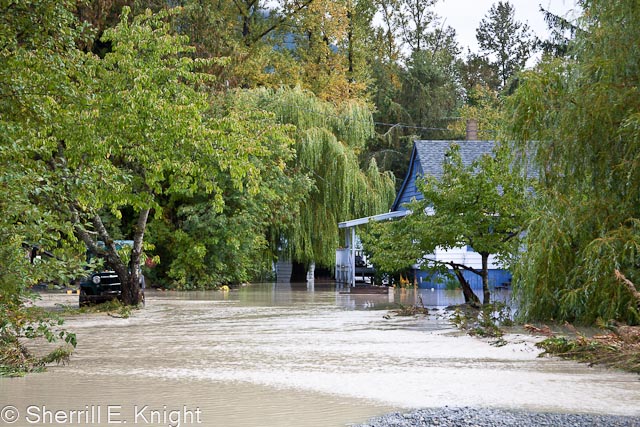 | |
| House in Hagensborg |
About mid-afternoon, a local invited us to their house for tea. A few hours later, however, the road to their house was under water, and threatening to be washed out by the rapidly moving water. So, with the threat of being cut-off, we helped these people load up a few things, mainly food and clothing, and we headed further up-valley and up-slope to an empty house that was on well-water. The owners were working in Vancouver. This is where we stayed, safely above the flood for the next two days. We slept in our camper, and shared our meals and cooking with our new friends and hosts, Stewart, Shirley and Marilyn, their four canine pals, and friends, Mike and Clare. While this was happening, Stewart headed off to work on the local roads and clearing culverts of debris with other road crews.
 |
 |
| Olsen Road Wash-out, Hagensborg |
 |
| Tire tracks in muds deposited by flood. Heavy shoveling! |
We learned that Tweedsmuir Travel was trying to organize a ferry with the BC government to evacuate stranded visitors like ourselves. The seasonal ferry that serves Bella Coola twice a week during the summer had just gone into dry-dock mid-September for its winter maintenance.
For the next two days, we retrieved and re-stacked firewood and other items that had floated away, and shoveled silt from buildings and basements at our host's place, and at some of their neighbor's nearby.
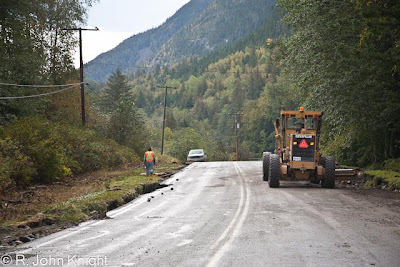 |
| Grader repairing undercut road edges |
 |
| Road and bridge washout, Hagensborg |
On Wednesday evening, we heard that we were on a list of possible evacuees the next morning. The plan was to get us to Bella Bella aboard a small ferry, the Nimpkish, so that we could catch the southbound, Prince Rupert to Port Hardy ferry, the Northern Princess, Thursday evening.
We were up and out the door early on Thursday to make the drive down to Bella Coola. Work crews were busy everywhere repairing washed out and undercut roads.
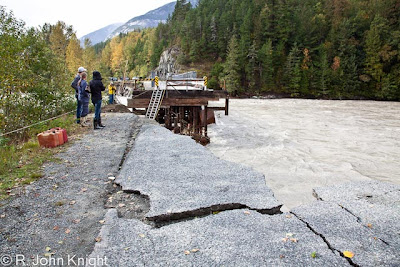 |
| Bridge approaches washed out |
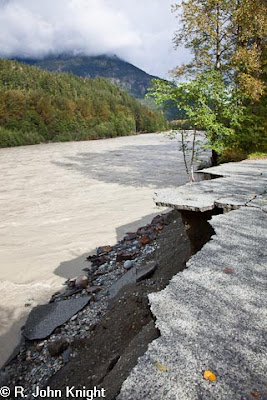 |
| Road to bridge undercut by flood waters |
At the ferry, we were initially told that our pop-up camper was too tall for the ferry. It was, after all a 'really small' ferry with a capacity of only 13 vehicles, of which only three could be taller trucks, trailers or campers. To make a long story short, we did get on. They had us back on, and with some jockeying around, we put the nose of our truck in under the area for cars.
We left Bella Coola about 0900 with mixed feelings. Part of us wanted to stay and help, but we were extra mouths to feed, and food supplies were getting low in the community. When we heard that other ferry evacuations might be uncertain during the following week, we decided that it was best to take the opportunity and leave.
We left Bella Coola about 0900 with mixed feelings. Part of us wanted to stay and help, but we were extra mouths to feed, and food supplies were getting low in the community. When we heard that other ferry evacuations might be uncertain during the following week, we decided that it was best to take the opportunity and leave.
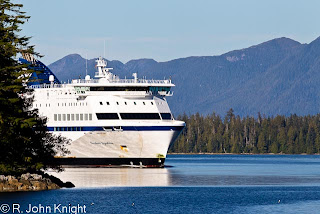 |
| Northern Explorer, Bella Bella |
The Bella Coola flooding was the worst on record for the community, i.e., with 309 mm of rain falling within 36 hours, the river came up 4 m. Roads and bridges were washed out. Homes were flooded; some washed away. The damage was extensive.
Almost three weeks later, the only road to the outside is still being repaired (re-constructed). Limited essential traffic can use the road under escort. It will be months before it is properly fixed. In the meantime, food and fuel comes in by barge. As if this were not enough, grizzlies and cougars are now wondering through the community in larger than usual numbers as they forage for food to replace the salmon from the annual run.
Yes, we missed our week to photograph the grizzlies, but there will be other years. Obviously, this is where we were meant to be this year, and by being there and through helping others in need, we met some truly amazing and courageous people.
After escaping to Vancouver Island, we stopped to visit our daughter and son on the way home. Being touch was family after such an experience seemed really important. Our trip to coast and back turned out to be more of an adventure than we had planned!
 |
| Bella Coola at sunrise |

